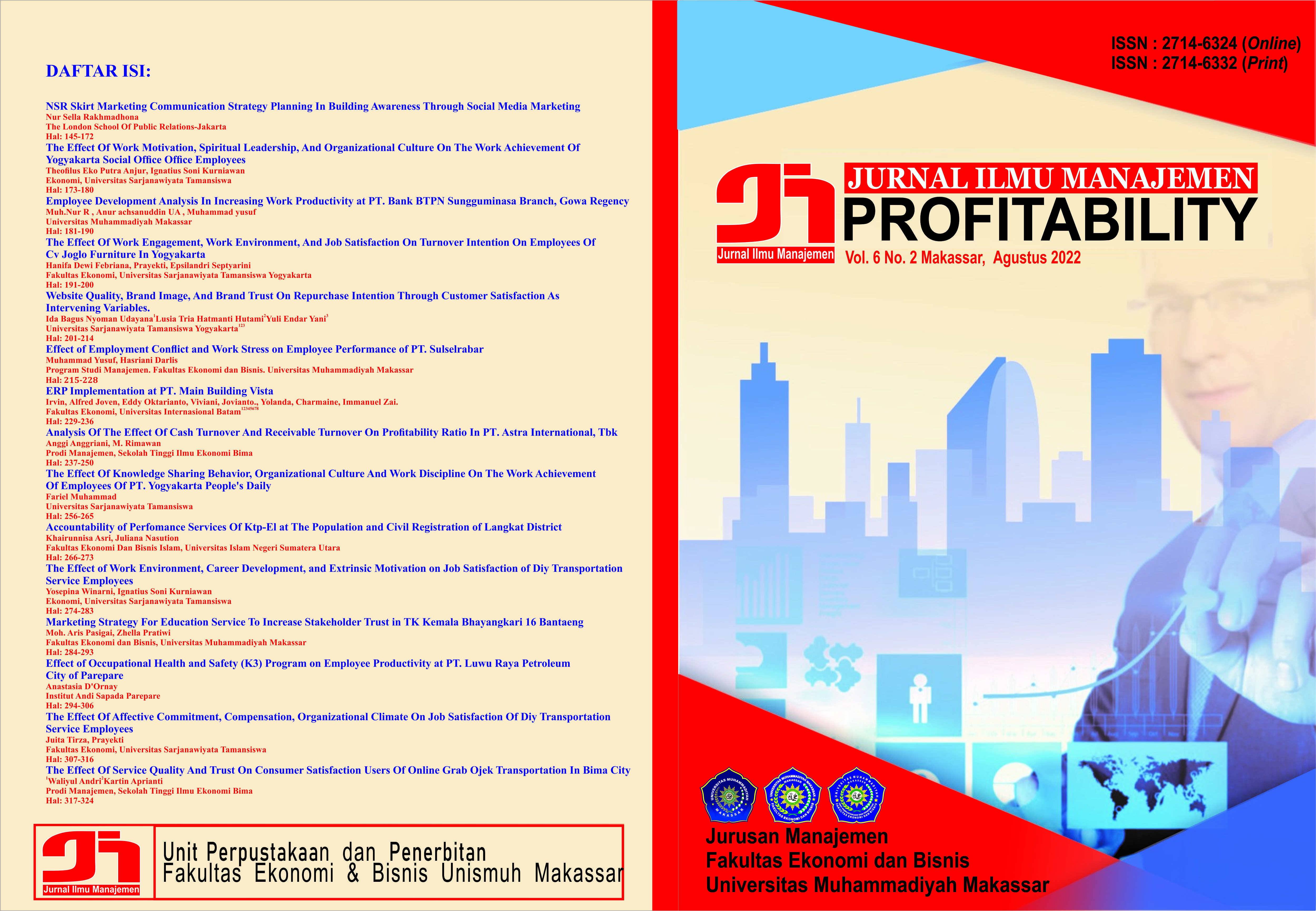Employee Development Analysis In Increasing Work Productivity at PT. Bank BTPN Sungguminasa Branch, Gowa Regency
DOI:
https://doi.org/10.26618/profitability.v6i2.8460Kata Kunci:
Development, Work productivityAbstrak
The purpose of this study was to determine the effect of employee development on work productivity at PT. Bank BTPN Sungguminasa Branch, Gowa Regency. Employee development is one of several factors that can affect the level of work productivity. Development is an additional basic salary that is not expected by employees, but only part of it can be given only having certain achievements or certain skills and do not bother when asked to complete as soon as possible, such as reports or receipts that must be reported. This research was conducted using a simple linear regression analysis tool, R2 test and t test to analyze the close relationship of 1 variable, and the results of the discussion that the value of the variable regression coefficient (X) or employee development is 0.458 so it can be said that the employee development variable (X) positive effect on work productivity by 45.8%. From the results of the regression analysis, the t-count value was 3.524 > t-table was 2.042 and the significance value (sig.) was 0.001 <0.05. So it can be concluded that Ho is rejected and Ha is accepted, which means that employee development (X) has a significant effect on work productivityReferensi
Basit, Acep Abdul, 2017, Pengaruh Motivasi Internal Terhadap Produktivitas Kerja Karyawan Di PT. INDOSAT Tbk CABANG GARUT
Efendi, N.T, 2010, Sumber Daya Manusia dan Peluang Kerja Kemiskinan, Edisi Kedua, Cetakan Kedua, Mandar Maju, Yogyakarta.
Flippo, E. B., 2010, Principles Of Personnek Management, Third Edition, McGraw Hill Gakusha, Tokyo.
Fibriany, F.W, 2017, Peningkatan Produktivitas Melalui Pelatihan Karyawan Pada PT.GIORDONA INDONESIA, Cakrawala, vol. XII, No.2
Handiko, H, T, 2012, Manajemen Sumber Daya Manusia, Cetakan Pertama, Mandar Maju, Bandung.
Hasibuan, SP, 2011,Manajemn Sumber Daya Manusia, Edisi Kedua, Ghalia Indonesia, Jakarta.
Heidjrachman, R, dan Suad Husnan, 2010, Personnel Adminitrasion and Human Resuorces Management, New York, Jhon Willey & Sons.
Kusriyanto, B, 2010, Meningkatkan Produktivitas Kerja, Sei Management, PT. Pustaka Binaman Pressindo, Jakarata.
Kandou, E.E, 2009. Pengaruh Pelatihan Dan Pengembangan Karyawan Terhadap Produktivitas Kerja.
Ichsan, A, 2010, Tata Adminitrasi Karyawan, Bagian II, Jambatanm Jakarta.
Manullang, M, 2010. pengantar Manajemen, Balai Pustaka, Jakarta.
Nitisemito, Alex S, 2009 , Manajemen Sumber Daya Manusia, Cetakan
Noroni, Andri Mohamad, 2016, Pengaruh Strategi Pengembangan Dan Kualitas Karyawan Terhadap Kinerja Karyawan Pada PDAM TITRA INTAN GARUT.
Ranupandojo. H. 2012, Manajemen Personalaia, Edisi Kedelapan, Cetakan Kelima, Bina Aksara, Bandung.
Rosmadi.Maskarto Lucky Nara, 2018, Analisis Faktor-Faktor Karyawan Dalam Meningkatkan Produktivitas Perusahaan.
Ranupandoyo. H. dan Suad Husnan, 2012 ,Personnel Administration dan Human Resurces Management, New York, John Willey, & Sons.
Riani, Asri Laksmi, MS, Dr., 2013 Manajemen Sumber Daya Manusia Masa Kini.Yogjakarta: Graha Ilmu.
Sugiyono.(2011) Metode Penelitian Kuantitatif dan Kualitatif dan R & D.
Bandung: CV Alfabeta.
Sari, Juwita 2009.’’Analisis Pengembangan Karyawan Dalam Meningkatkan Kualitas Kerja Pada PT. Bank Muamalat Indonesia, Tbk Cabang Medan”.Skripsi.Dipublikasikan (Online). Medan: Universitas Sumatera Utara Fakultas Ekonomi
Unduhan
Diterbitkan
Terbitan
Bagian
Lisensi
Authors who publish with Jurnal Ilmu Manajemen Profitability agree to the following terms:
Copyright of the articles remains with the authors.
Authors grant the journal the right of first publication with the work simultaneously licensed under a Creative Commons Attribution-NonCommercial 4.0 International License (CC BY-NC 4.0). This license allows others to:
Share (copy and redistribute the material in any medium or format)
Adapt (remix, transform, and build upon the material)
as long as they give appropriate credit to the original author(s) and source, provide a link to the license, and indicate if changes were made. Non-commercial use only.
Authors are permitted to:
Distribute their published work (e.g., post it to an institutional repository or publish it in a book), with an acknowledgment of its initial publication in this journal.
Enter into separate, additional contractual arrangements for the non-exclusive distribution of the journal’s published version of the work (e.g., post it to a class website or institutional archive).
For permissions to use the content published in this journal beyond the scope of the license (e.g., commercial purposes), please contact the editorial office via the journal email.
License Details:
This journal is licensed under a Creative Commons Attribution-NonCommercial 4.0 International License (CC BY-NC 4.0).

